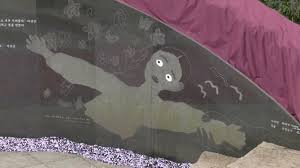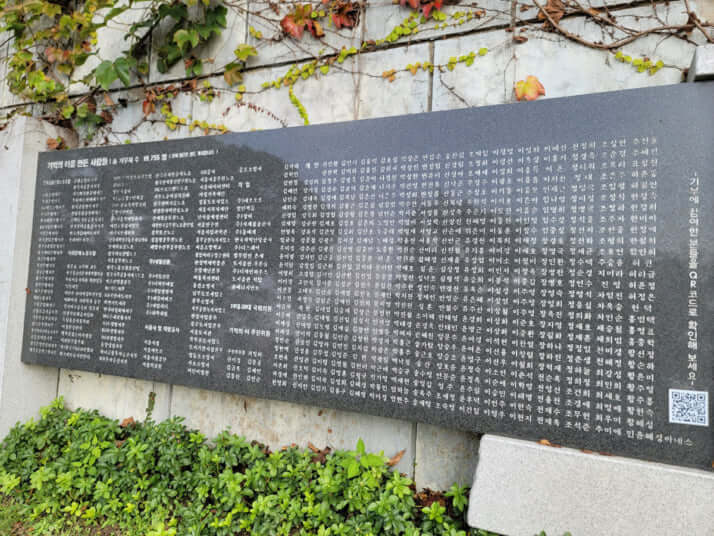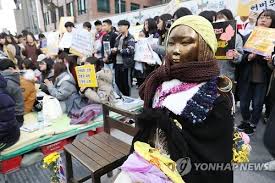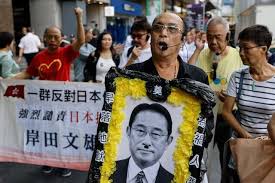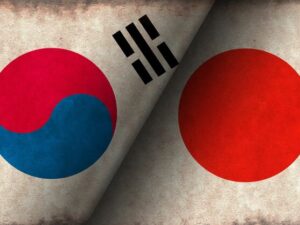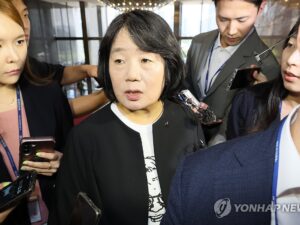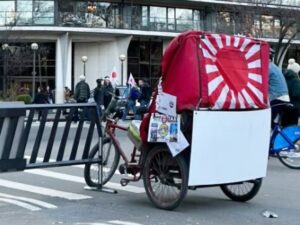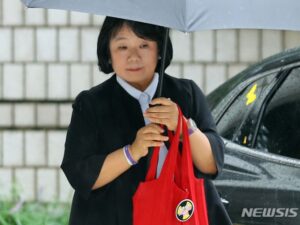At 6:00 a.m. on September 5, a loud noise rang out on the slope leading to Namsan Tower in Seoul, a popular destination for foreign tourists. Power shovels were being brought into the narrow street and trucks were passing by. The construction work had begun to remove some of the sculptures in the “Place of Remembrance,” known as the Memorial Park for the Japanese Comfort Women. On the same day, the city of Seoul removed the “Eye of the Earth” and “Navel of the World” sculptures that had been installed there. The “navel of the world” was also removed… and the site was left in ruins.
The “Memory Site” was created in 2016 at the initiative of the Seoul Metropolitan Government and civic groups as a large park to memorialize the victims of the Japanese comfort women. The mayor of Seoul at the time was Park Won-Soon, a man of leftist tendencies. The citizens’ group formed a committee and held demonstrations every Wednesday near the Japanese Embassy in Korea. They are known to have promoted the construction of the “Memory Site. During the Moon Jae-in administration, the site was also called a sacred place for victims of military comfort women and became a popular stop for visitors to Namsan. In 2020, Mayor Park took her own life after allegations of sexual harassment against a female secretary, and conservative-leaning Mayor Oh Se-hun was elected as the new mayor in a by-election in 2009. From his early days in office, Mayor Oh criticized the citizens’ group that had promoted the “Place of Remembrance” movement while receiving budgetary support from the Seoul Metropolitan Government. In addition, a sex scandal broke out involving the artist Lim Ok-sang, who created the “Eye of the Earth” and “Navel of the World” sculptures at the “Site of Remembrance. Im was indicted in June of this year and convicted by the court in August on charges of forcibly holding and kissing a female employee who worked for him and committing other indecent acts. In addition to six months in prison (suspended for two years), he has been sentenced to complete a 40-hour treatment program for sexual offenses. For Mayor Wu’s side, this has created a name for the city: placing a work by a person convicted of sexual harassment at a memorial site for military comfort women is unacceptable ……. And so the city of Seoul announced the removal of Hayashi’s work.
The civic group is dead.
Of course, the civic groups that had promoted the construction of the “Place of Remembrance” opposed the city’s decision to remove the work. In particular, members of the Jeongwiyeon, a well-known comfort women’s group in Japan, held a press conference at the “Memory Site” the day before the removal of the sculptures and announced that they would prevent their removal. They claimed that “Seoul City is trying to erase the history of comfort women under the pretext of Mr. Im Ok-soo. Public opinion, however, did not defend this claim. The city of Seoul also claimed that “the city of Seoul is trying to erase the history of the comfort women by using Ms. Lim Ok-soo as an excuse. The Seoul Metropolitan Government also stated firmly, “We will definitely remove the works of sexual offenders because they cannot be placed in a space that remembers comfort women,” and “The Seoul Metropolitan Council should also listen to the voices of citizens without interfering with the legitimate execution of public duties. The city of Seoul’s concerns about the action to prevent the removal of the monument proved to be unfounded. There was no obstruction of any kind. Immediately after the removal, Mayor Wu posted on his SNS account, “Civic groups are dead,” and “For an organization dedicated to protecting victims of Japanese military comfort women to try to prevent the removal of a work by an admitted sexual harasser is to deny its own reason for existence,” condemning the Positive Council and other civic groups. Today, only grass, rocks, and grave-like marks remain where the “Eye of the Earth” and “Navel of the World” used to be. P., 45, an office worker who saw the footage, said, “The mayor of Seoul is still in charge of the city. If the mayor of Seoul was still Park Won-soon, I don’t think the removal would have proceeded as smoothly as it did. Political interests have always taken precedence in the comfort women issue.
Ri Jae-myung’s Activities Concerning the Statue
What is of interest is the current status of the comfort women statue, which is considered a symbol of the comfort women issue. The statues, known as “Girls for Peace” in South Korea, have been installed 100 times in Japan and abroad, but in recent years, they have come under increasing criticism. In recent years, however, the statues have come under increasing criticism because of allegations of fraud on the part of the organizations that have promoted their installation. However, since some of the statues are politically motivated, it is not easy to remove or relocate them. Take, for example, the comfort women statue in the plaza of Seongnam City Hall. Lee Jae-myung, a representative and member of the National Assembly of the “United Democratic Party,” was involved in the installation of the statue, for which a warrant was issued for his arrest on allegations of breach of trust and illegal money transfers, and he went on hunger strike to protest the current administration. In 2014, when Lee was mayor of Seongnam, he promoted the installation of a comfort women statue in collaboration with citizens’ groups. Citizens’ opinions were divided on the placement of the comfort women statue in the middle of the space in front of City Hall, which was open to the public, but Lee Jae-myung did not listen to them. In 2016, when then President Park Geun-hye ended comfort women-related talks with the Japanese government, Lee said, “If the government removes the statue of the Girl of Peace (in various locations) through humiliating negotiations between Korea and Japan, I will request that the statue be sent to Seongnam City.” He also attended the unveiling ceremony of the comfort women statue in Sydney, and in 2020, when the city of Berlin removes the comfort women statue, he sent a letter to the German side urging them to withdraw their removal. Because of this history, the removal of the statue in Seongnam City will not be easy.
Comfort Women Statue Nervous in South Korea
The political situation of the time also supported the installation of two other comfort women statues, one at the entrance to Sannoksu Station on Subway Line 4 in Ansan City, Gyeonggi Province, and the other in downtown Namyangju City, Gyeonggi Province. Both are areas where leftist political parties have occupied mayoral positions and the majority of local parliamentarians for a long period of time. Seongnam, Ansan, and Namyangju became mayors belonging to the ruling conservative party “Power of the People” last year. While the statue undoubtedly reflects the voices of citizens critical of the comfort women statue, it is said that the statue is unlikely to be removed or relocated due to its local nature, unless it is for a good cause such as the sexual crimes committed by Im, of the “Land of Memory. The comfort women statue is a nervous issue in Korean society. Any talk of their removal or relocation is expected to be met with fierce opposition from members of the left-wing opposition Democratic Party of Korea (DPJ) and left-leaning civic groups. If they promote the removal or relocation of the comfort women, they will be branded as pro-Japanese or traitors and may even be politically exploited by the left-wing parties. It could also have a negative impact on the approval rating of the ruling “People’s Power” party. It is said that the comfort women statue will become a point of contention between pro-Japanese and anti-Japanese factions.
Noh Min-ha (local journalist) Daily Shincho Editor
